Crazy 4 Poker Hole-Card Play
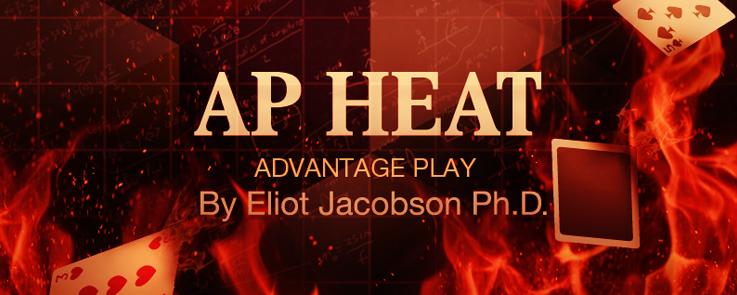
Crazy 4 Poker (C4P) has been among the most popular proprietary table games for many years. The only games that have had more placements in Las Vegas over the last 5 years are Three Card Poker and Let-it-Ride. It follows that advantage players are going to give this game a very close look. C4P has the key ingredient for a hole-card weakness: the player gets to make a strategic decision (fold/raise 1/raise 3) after the player and dealer receive their cards. The problem for the AP is that the amount of information that one hole-card yields is not enough to swing the edge his way.
In C4P, the player makes his best four-card poker hand from five cards he is dealt. The four-card poker hands are ranked as follows:
-
Four-of-a-Kind
-
Straight Flush
-
Three-of-a-Kind
-
Flush
-
Straight
-
Two Pair
-
One Pair
-
High Card
As usual for poker, the hands are ranked first according to their type and further compared based on the rank of the cards that make up the hand.
C4P follows the familiar format of a poker-type game with an Ante/Play structure. In addition, there is a required second wager that must be made on a “side bet” called the “Super Bonus” (SB) bet. This bet is not really a bonus or side bet at all. The player has a huge edge on the main game; the SB bet is designed to have an even larger house edge, giving a net edge to the house overall.
Here are the rules:
-
The player makes an Ante wager and an equal wager on the SB bet.
-
The player and the dealer are each dealt five cards, face down.
-
The player then chooses to fold or play.
-
If the player folds, he forfeits his Ante and SB bet.
-
If the player makes a Play bet and has less than a pair of Aces, then his play bet must equal his Ante.
-
If the player makes a Play bet and has a pair of Aces or higher, then his Play bet must be either 1x or 3x his Ante.
-
If the player makes a Play bet, then the dealer’s hand and player’s hand compete.
-
The player makes the best four-card poker hand using any four of his five cards.
-
The dealer makes his best four-card poker hand using any four of his five cards.
-
The dealer qualifies with a hand that is King high (K432 off-suit) or higher.
-
The wagers on the main game and SB bet are resolved according to the criteria below.
Here are the payout criteria for the main bet:
-
If the dealer does not qualify, then the player is paid 1-to-1 on his Play bet and his Ante bet will push.
-
If the dealer qualifies and the dealer’s hand beats the player’s hand, then the player forfeits both his Ante and Play bets.
-
If the dealer qualifies and the player’s hand beats the dealer’s hand, then the player is paid 1-to-1 on both his Ante and Play bets.
-
If the dealer qualifies and the dealer’s hand ties the player’s hand, then the Ante and Play bets both push.
Here are the payout criteria for the SB bet:
-
If the dealer does not qualify and the player has less than a straight, then the SB bet pushes.
-
If the dealer qualifies and the player has less than a straight and the dealer’s hand beats the player’s hand, then the player forfeits his SB bet.
-
If the dealer qualifies and the player has less than a straight and the player’s hand beats or ties the dealer’s hand, then the SB bet is a push.
-
If the player has a straight or higher then the SB bet is paid according to the following pay table:
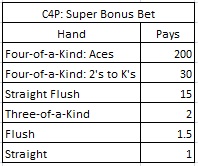
Basic strategy for the main game is not as easy as its relative, Three Card Poker, with its trivial Q64 strategy. In this game, suits matter. For example, in computer-perfect play, the player should raise 1 with (KH, QH, 7C, 6D, 4C); the EV for raising 1 unit is -1.9995. On the other, the player should fold the hand (KH, QH, 8C, 4H, 3D); the EV for raising 1 unit is -2.0006. In practice, however, these close plays don’t matter much. The hands are rare and the cost of misplaying the hand is small.
On the other hand, the strategy is trivial for raising 3 times the Ante. According to the rules, the minimum hand the player is allowed to make a play bet equal to 3x the Ante is holding a pair of Aces. The player should always raise 3 with a pair of Aces or better.
The following table gives the baseline house edge and the edge using several different strategies:
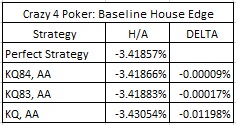
The laziest strategy to implement, playing KQ or higher, returns 0.01198% less than playing perfect basic strategy. In other words, the KQ strategy costs about 12 cents per $1000 wagered.
In the situation where the AP has full knowledge of one of the dealer’s five hole-cards, the house still has the edge to the tune of 2.7504%. A single hole-card is worth only 0.6682% to the AP.
The following table gives a simple suit-free hole-card strategy. The hole-card player should raise 1 with the indicated hand or higher. As usual, with a pair of Aces, raise 3.
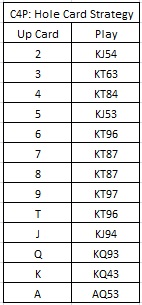
This strategy yields a house edge of 2.7523%, making it 0.0019% weaker than computer-perfect play. Using this strategy will cost about 2 cents per $1000 wagered.
Finally, the AP can gain an edge in an extraordinarily weak game where the dealer exposes two or more hole-cards. Computer-perfect two-hole-card strategy gives a player a 0.803% edge over the house. That’s not only a pretty low edge, it also comes with very high variance due to the SB bet, a lack of opportunities and a tough strategy.
Here are the cut-off points for the two-hole-card game when the AP sees that the dealer has a pair.
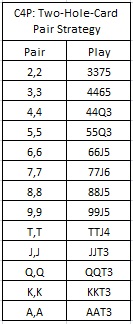
Note that if the dealer shows a pair of Aces in the hole, then with AAT3 or higher the AP should raise 3, otherwise he should fold.
Like Four Card Poker, the game of C4P is not significantly vulnerable to hole-card play. A lot of things have to go very wrong for the AP to get an edge using a hole-card strategy. The following are my recommendations for protecting Crazy 4 Poker:
-
Remind dealers of correct procedure.
-
Routinely audit dealers for hole-card exposure.
-
Put in a policy for the players to make their fold/play decision before the dealer takes his cards.
-
Beware of the possibility of player/dealer collusion.


